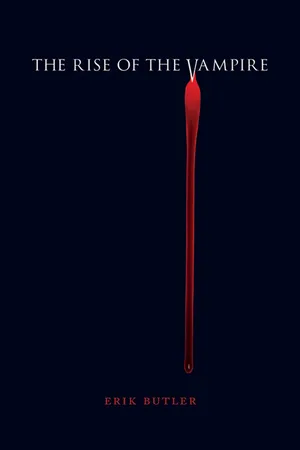
- English
- ePUB (mobile friendly)
- Available on iOS & Android
The Rise of the Vampire
About this book
Before Bella and Edward; Stefan and Damon Salvatore; and Abraham Lincoln, Vampire Hunter, there was Lestat and Louis, The Lost Boys, and Buffy Summers. Before True Blood and Let the Right One In, there was Dark Shadows and Anne Rice's Vampire Chronicles. And then there is the most prominent of them all: Dracula, immortalized by Bram Stoker in 1897. Whether they're evil, bloodsucking monsters or sparkling like diamonds in the sunlight, vampires have been capturing our imagination since their modest beginnings in the rustic fantasies of southeastern Europe in the early eighteenth century. Today, they're everywhere, appearing even in movies in Japan and Korea and in reggae music in Jamaica and South Africa. Why have vampires gone viral in recent years? In The Rise of the Vampire, Erik Butler seeks to explain our enduring fascination with the creatures of the night. Exploring why a being of humble origins has achieved success of such monstrous proportions, Butler considers the vampire in myth, literature, film, journalism, political cartoons, music, television, and video games. He describes how and why they have come to give expression to the darker side of human life—though vampires evoke age-old mystery, they also embody many of the uncertainties of the modern world. Butler also ponders the role global markets and digital technology have played in making vampires a worldwide phenomenon. Whether you're a fan of classic vampire tales or new additions to the mythology, The Rise of the Vampire is a fascinating look at our collective obsession with the undead.
Frequently asked questions
- Essential is ideal for learners and professionals who enjoy exploring a wide range of subjects. Access the Essential Library with 800,000+ trusted titles and best-sellers across business, personal growth, and the humanities. Includes unlimited reading time and Standard Read Aloud voice.
- Complete: Perfect for advanced learners and researchers needing full, unrestricted access. Unlock 1.4M+ books across hundreds of subjects, including academic and specialized titles. The Complete Plan also includes advanced features like Premium Read Aloud and Research Assistant.
Please note we cannot support devices running on iOS 13 and Android 7 or earlier. Learn more about using the app.
Information
REFERENCES
Introduction: The Mystery and Mystique of the Vampire
ONE: Portrait Gallery of the Undead
Table of contents
- Front Cover
- Half Title
- Title Page
- Copyright
- Contents
- Introduction: The Mystery and Mystique of the Vampire
- ONE: Portrait Gallery of the Undead
- TWO: Generation V
- THREE: All-American Vampires (and Zombies)
- FOUR: That Sucking Sound
- FIVE: The Key to Immortality
- Conclusion: Vampires, Inside and Out
- REFERENCES
- ACKNOWLEDGEMENTS
- PHOTO ACKNOWLEDGEMENTS
- INDEX